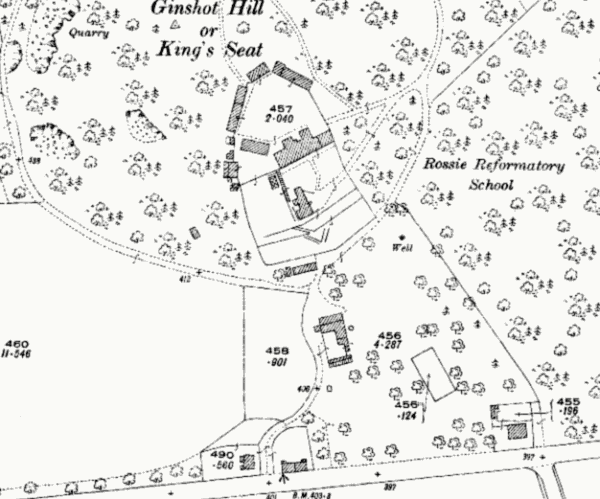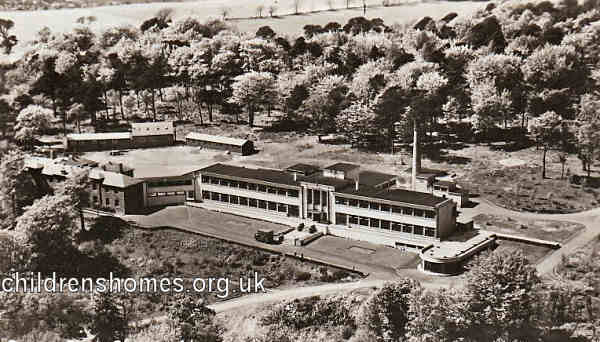Rossie Reformatory for Boys / Rossie Farm School, Montrose, Angus, Scotland
The Rossie Reformatory for Boy was established by William Macdonald Macdonald in a cottage on his estate, about five miles to the south-west of Montrose. It was formally certified for operation on 4 May 1857 with accommodation for 10 boys. The cottage had a dormitory on its ground floor, together with a cell and a small closet. The staff consisted of the superintendent, Mr David Keay and his sister, Janet, plus a labourer named Webster.
The School came under criticism from local officials in June 185 after it was revealed that a ten-year-old inmate named William Burns had been flogged for the theft of thirty shillings from the superintendent and for refusing to reveal where he had put it. The boy was also confined in the School's cell for a period of thirty-seven days. The institution's rules regarding punishment were revised following the incident.
In 1859, new buildings were erected to increase the number of places at the School to thirty, later rising to forty. The superintendent continued to reside in the cottage, with one of the assistant or industrial teachers occupying the room in the new building, and taking charge of the boys at night.
The 1862 inspection report noted that seven boys on the roll of inmates absent, having absconded since the beginning of the year, and not having been recovered. More than twenty other attempts at desertion had occurred in the year, and on a very recent occasion 15 of the boys had gone off at once, without any special excuse or cause of excitement. Absconding for a few days seemed to have become a chronic complaint. The inspector attributed this problem to the lax discipline of the school and the trifling punishments inflicted on the boys who had thus deserted, even repeat offenders. They consisted chiefly in privation of the daily biscuit, or occasionally of the allowance of meat. The master, while a conscientious and judicious man, appeared to lack the necessary activity and vigour of character. It was also suggested that the School's religious instruction was too much laboured, and the industrial employment too limited.
In 1866, the School's managers added 75 acres to the land held by the institution, making the total 105 acres, which was held on a 99-year lease. The School buildings were also enlarge, adding a workshop and store-room on the ground floor, with a 16-bed dormitory above. Further additions in 1870 provided new tailors' and shoemakers' shops, and the playground was also enlarged. The industrial employment now largely consisted of farm work, tailoring, and shoemaking. The 1870 inspection described the School as very well managed and the Mr Keay was now said to be a man of 'active, energetic habit'. Only one case of absconding had occurred during the year.
Further building work took place in 1879, providing a new dormitory and sick-room. A new shoe-maker's shop was added in 1882. The farmland now extended to about 50 acres, all reclaimed by the boys from woodland and moor.
The School site is shown on the 1927 map below.

Rossie Reformatory for Boys site, Montrose, c.1927.
The matron, Miss Janet Keay, died in 1885 after having been with the School for 29 years. She was succeeded by Miss Forbes. Mr Keay resigned as superintendent the following year. Mr and Mrs Alexander McEwen were subsequently appointed as superintendent and matron. In the interregnum, however, the School had fallen into a very bad order, with disagreements among those in charge, and a lack of firmness and discipline, resulting in many cases of absconding. Six of the boys had been sent to prison. A mark system was introduced giving rewards for good conduct. Many of the boys worked on the farm, but 20 boys were in the tailor's shop, making and mending, plus 12 making and repairing stockings, while 19 worked in the shoemaker's shop. The farm's livestock included eight cows, and some young stock, three horses, and a good many poultry. There was now a brass band of 18 performers, taught by the schoolmaster.
In 1889, it was reported that some of the boys worked out amongst the neighbouring farmers. In the wood there was a large undergrowth of bilberries, and no less than two tons had been gathered and sold in the previous season.
The 1896 inspection described the premises as a plain building beautifully situated on the borders of Rossie Woods. The workshops were situated on the far side of the playground, and the superintendent's house about 60 yards in front of the main building and connected with the teacher's room by electric bell. The farm buildings are a little distance lower down the bill and are well kept. A new tailor's shop had been built and it was proposed to convert the old one into a well-fitted bathroom and lavatory. Water was obtained by hand power from a well, and the drainage was into a cesspool at the foot of the hill and about 200 yards from the school. The dormitories are good but the provision for a sickroom was said to be quite inadequate. In the classroom, singing (sol-fa) was rated as 'fair', composition as 'very fair' and mental arithmetic from 'good' to 'very fair' in the different standards. In the winter, schooling was carried on before breakfast and after supper, but in the summer from 10 a.m. to 1 p.m. The deployment of boys to the various industrial occupations was: 22 tailors (including shirt-makers and stocking darners), 23 shoe-makers (including institutional and some outside work, both trade and private), and 20 boys working on the farm (now about 60 acres of arable and grazing land, with 8 milk cows, 10 young stock, 3 horses, a few pigs, and 100 head of poultry). There was a very good playfield which was used every fine night in summer and on Saturday afternoons in winter. Nine football matches had been played with outside teams the previous winter, the boys winning most of them. Every Saturday in the summer, the boys bathed in the sea at Lunan Bay which lay two-and-a-half miles away. Several day-trips were made during the summer, including one to Rossie Castle, where a cricket match was played against a team of gentleman visitors, and one to Sunnyside Asylum Grounds (9 miles away) where a cricket match was also played. In the winter magic lantern and other entertainments took place in the schoolroom, and special treats were given at Christmas and the New Year. There were a large number of books in the school library, and Chamber's Journal and other periodicals were taken. The boys were also allowed to read the daily papers. The mark system provided rewards for work and general conduct, including the schoolroom. The total amount dispensed generally amounted to about £16 a year. Boys of good conduct were allowed to visit their friends for the day about three times a year. Miss McEwan had now been appointed as assistant matron.
In 1897, the old tailor's shop was converted into a new washroom with a good bath. New beds were supplied nearly throughout the School. Physical drill was conducted by the schoolmaster every evening. One boy who absconded was found in Belfast and was being brought back, but when within two miles of the School bolted again and had not been heard of since. One boy cut off his finger to avoid work.
Additions to the buildings in 1900 provided a new sick-room and dormitory, and an enlargement of the school-room and one of the existing dormitories. A new laundry was erected in 1902, together with a large greenhouse in the garden. Two acres of land were now laid out as a fruit garden and a gardener appointed. Drawing was added to the industrial training.
Mr and Mrs McEwan resigned their posts in February 1903 and were succeeded by Mr James Carson as superintendent and Miss Martin as matron. Mrs Carson was appointed matron in September of the same year. The boys were now clad in knickerbockers and Lovat's mixture Jerseys. All had been supplied with woollen vests. Twenty boys received regular instruction in carpentry from the Rev. W. Fairweather. The products of their work included ladders, picture frames and a writing desk. A drum and life band was formed. New rifles were bought this year and military drill started. Gymnastics now included free exercises with dumb-bells and the Swedish system of movements.
In January 1909, a new water supply was installed providing 900 to 1000 gallons per day. The following year, a miniature outdoor rifle range was opened, and a club formed and affiliated with the N.R.A. The capacity of the School was now 90 places.
In 1933, Rossie became an Approved School, one of the new institutions introduced by the Children and Young Persons (Scotland) Act to replace the existing system of Reformatories and Industrial Schools. Renamed Rossie Farm School, it then accommodated up to 70 Senior Boys, aged from 14 to 18 years at their date of admission. The superintendent in 1934 was still James Carson who by then had become a recipient of the M.B.E.
By 1943, the headmaster, as he was now termed, was Mr W.S. Low. At that date, the establishment was described as a country school with a large farm and garden, with training also given in woodwork and carpentry. The pipe band was still active.

Rossie Farm School, Montrose, date unknown.
Following Scotland's 1968 Social Work Act, the establishment became a 'List D' School. By the mid-1970s, a Secure Unit had been established at the site. The School was subsequently redesignated as a Young Offenders Institution. The site is now managed by Rossie Young People's Trust.
Records
Note: many repositories impose a closure period of up to 100 years for records identifying individuals. Before travelling a long distance, always check that the records you want to consult will be available.
- None identfied at present — any information welcome.
Census
Bibliography
- Higginbotham, Peter Children's Homes: A History of Institutional Care for Britain s Young (2017, Pen & Sword)
Links
Except where indicated, this page () © Peter Higginbotham. Contents may not be reproduced without permission.


